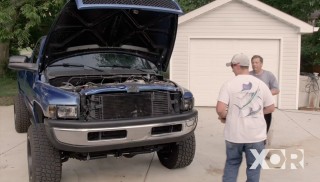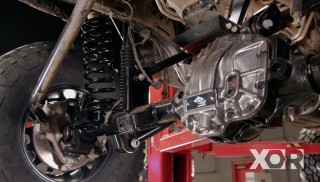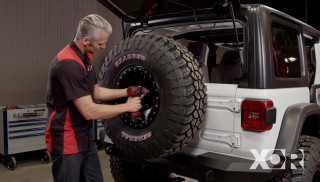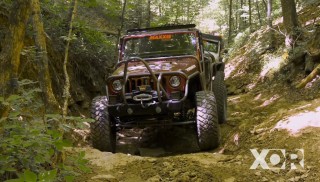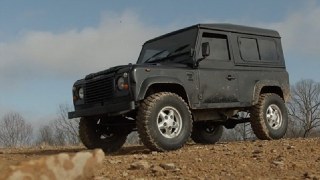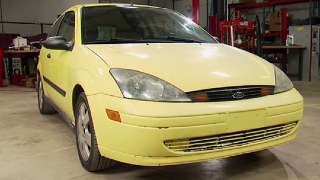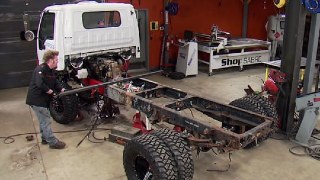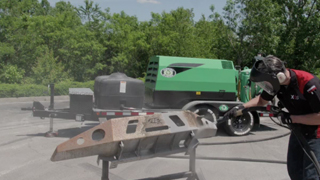XOR - Xtreme Off-Road Builds
Want more content like this?
Join the PowerNation Email NewsletterParts Used In This Episode
Lincoln Electric
Lincoln Electric is the official welding supplier to XOR
Matco Tools
MATCO Tools are the Official Tool Supplier to XOR
Rusty's Off Road
Skid Plate System for Jeep JL
The Industrial Depot
Tools, Hardware, and Shop Supplies
Episode Transcript
(Narrator)>> Today on XOR Jeremy upgrades our Jeep JL with some new treads. Plus Eliza slaps some armor on the belly of this beast, and our Tacoma gets a cosmetic overhaul from front to back right now on XOR.
(Eliza)>> Hey guys, welcome to XOR. Today we'll be working on both our rigs. Our Tacoma is getting some trail worthy parts that'll be painted to match so it looks good on the trail, and the JL, well Jeremy's got some awesome plans for that.
(Jeremy)>> We'll be ditching the stock wheels and tires and upgrading to something that is a little more fitting to this build. Plus we're gonna be adding some under body protection to make sure all the inner workings of our JL stay nice and safe. Thanks to our Rusty's Off Road suspension system we now have the flex that we're looking for but it's time to start thinking about the ground clearance. So we're gonna be adding some bigger tires so we can take this thing down some more technical trails because with bigger tires comes more ground clearance. Now General sent us a set of their Grabber XThree's. Now these are an aggressive mud terrain tire that have extreme off road performance in mud, dirt, and rocky terrain. They also have a pretty impressive on road performance, and these 37 12-50 17's are gonna fill up the wheel well on our JL perfectly. Now for us, our JL, and our 37's we're gonna be running a set of bead locks. Now bead locks not only look cool on those trucks you see sitting in the parking lot, they actually do serve a purpose. Bead lock wheels and standard wheels really only have one similarity. They use the big thick part of the tire called the bead and the air pressure to hold that tire out onto the beads of the wheel. Now that works great if you're running full air pressure in your tires but we're gonna be out on the trails and we're gonna take a bunch of air out of our tires to increase the foot print of our tire and to give us more traction. So when we get rid of that air it takes away that force that holds that tire onto the wheel. Well that's where bead locks come into play. Now a bead lock wheel is like a two piece designed wheel in the fact that it's got an outer ring that you use to actually lock the tire on. It's got all these little grooves in the back so that way when we mount the tire on the lip here we can actually hold that tire onto the wheel. Then we're gonna putting a whole mess of bolts in here to help everybody stay together when we're out on the trail and when we let all that air out of the tire. So now all we've got to do is mount this wheel on to the tire, grab the mess of other wheels and tires we already mounted up, get them on the JL and we're one step closer to making this thing fly down the trails.
Getting past the first lip can be a little tricky but with a little bit of gentle persuasion it falls right into place. After installing the ring and a mess of bolts...
...we'll tighten them down in a criss cross pattern. I want to pull the ring down evenly. So I'll switch over to a ratchet so I can control how it seats, and the last step is to torque them down to 25 foot pounds.
Now it's time to throw these on the JL. Set it on the ground and see how these bad boys look.
We'll throw on some black jewelry to match our black wheels, and then just snug them up.
Man those tires fill up the wheel well perfectly but we've got one more tire that we've got to think about.
Now our big tires will not fit on the back of our JL but Rusty's Off Road has a solution for it. They sent us a relocation bracket that just moves the stock carrier. That way we can bring our big 37 with us. I'll start by removing the spare tire and our stock tire carrier, and the Rusty's bracket goes in the stock location using the stock hardware. [ drill spinning ]
(Jeremy)>> And then simply install the stock carrier onto the Rusty's bracket. [ drill spinning ]
(Jeremy)>> Then the 37 goes on the back. And the best part is the backup camera still works.
(Eliza)>> Hands down one of the best modifications you can have for any off road rig is adjusting your tire pressure, or airing down, and yeah I know a lot of you guys say that it just doesn't make a difference, and what about the sidewall bruising, but I'm gonna show you with the tread foot print how much you stand to gain by losing some of those p-s-i's. We're starting our baseline at 37 p-s-i to give us a kind of foot print that a normally daily driver aired up tire will leave.
Okay let's measure our tire width. We're at 10.5 there and nine and a half here. So we're not using our full width of the tire. Let's go ahead and try something different. As a very rough off road guide dropping the pressure about 25 percent will significantly increase traction, add comfort on rough dirt roads, wash boards, and moderate trails.
Okay so we've got half an inch of tread pattern here. Now we're gonna make a substantial drop to 15 p-s-i to see how much more tread contact we can get. Dropping the air pressure to about 15 p-s-i elongates the tire's footprint enough to enhance grip on slick rock and allows it to deform and cling onto big rocks. Okay let's compare it to our baseline. You can begin to see that our knobs have more contact on the ground, and while we might not be gaining a whole lot width wise we are definitely gaining length wise. Let's go ahead and check that out. Alright so we've got about eight inches of contact there to about 10. Let's go ahead and air down some more and see what we get. Cutting down to five p-s-i will nearly double the length of contact patch and allow you to float over very soft sand or mud. Let's check this to our baseline. We have nearly doubled our contact patch here, and you can see that we have full use of all of our lugs and our sipes. The only thing about running five p-s-i though is that you want to make sure that you're running them with bead locks so that you don't pop a bead out on the trail cause that would be for a very bad day. Another thing that we don't think about is that added traction means less erosion of our trails. You don't want to add any more ruts or be displacing any rocks while you're out trailing. So air down and tread lightly.
(Narrator)>> Up next Eliza protects the belly of our JL, but first we break out the tape for our new driveshafts on XOR.
(Eliza)>> Even though we've gained some belly clearance and have sick articulation sometimes the darn rigs just go where they want to go, and it never fails they end up right on the rock or obstacle that you're trying to go around. Now I know all of us say that's not me, but if and when it does happen you're gonna want some solid skid plates to make sure that your baby is okay. But before we can install skid plates I'll solve for driveshafts. With a couple of torque bolts and a whole lot of finagling our front shaft comes right out, and the same for the rear. Leaving me an open area to get all measurements needed. To measure for our front driveshaft we are going to be measuring from our front differential flange over to our transfer case flange.
Okay we are at 39 inches and a quarter. Okay so we're gonna measure the rear, and again it's going to be flange to flange.
Alright looks like we're sitting at 48 and a half.
When custom ordering your driveshaft you're gonna need to know a couple of things about the driveline you're running, such as whether you're using a yoke and/or c/v flange. U-joints come in a varied amount of sizes and styles. This is an example of a bolt on yoke. It's commonly found on your pinion side of the driveline. Your U-joint fits in here and is secured by bolts. The other is a press in style yoke. So your U-joint is pressed in here and is secured by clips, and is usually found on the side of the driveline that either slips into the transmission or the T-case. Our Jeep has a combination of both U-joint as well as c/v flange, and the reason why we use c/v flanges is because they can articulate with less bind and less vibration, making it perfect for your off road vehicle that also serves as your daily. [ mechanical humming ]
(Eliza)>> While I was under the JL measuring I was able to get a good look at the underside of our Jeep, and I found a couple of places where we could benefit from using Rusty's skid plates. If you recall we got hung up on a staircase while out testing the baseline of our Jeep. We bent some brackets, crushed our crossmember, and destroyed our front steering dampener. Thankfully though Rusty's will have us covered so it doesn't happen again. Here we have most of what makes up the JL full skid plate system that Rusty's Off Road offers. What makes this system unique is that you're able to build upon different skid plates to custom fit your Jeep needs. All of the skid plates are made with three-sixteenths steel and are E-coated to prevent rust, and they've also included these handy cutouts to make oil changes and access to key areas easy. Now let's get this started. First we'll start with the lower profile crossmember in preparation for adding our plates.
[ drill spinning ]
(Eliza)>> The first skid plate I'll add protects the engine, and it cleverly utilizes the motor mounts to attach the brackets that support the engine's skid plate.
And that's held in place with a couple of bolts that are included in the kit. Next we'll move on to the transfer case skid plate. It interlocks with the engine skid plate and ties into the frame. [ drill spinning ]
(Eliza)>> And just like the others the resonator plate bolts up to the adjacent skid plate and ties into the frame. And last but not least is the installation of the lower control arm skid plates. They weld onto the o-e-m brackets, which boxes them in and adds strength and protection. This well thought through skid plate system was an easy install, and will definitely add years of protective trailing to come.
No matter what part of the auto industry you're from we've all struggled one way or another getting ball joints pressed in or getting them pressed out. We've got Chad from Matco here and he's showing us their exclusive new ball joint tool.
(Chad)>> That's right, this is the brand new high pressure ball joint press that is really revolutionary in the market. Allows technicians to put a lot more force into the ball joint for removal and installation with lower torque on the bolts. It's allowing technicians to really put more power into there without hurting themselves or hurting the tools and things like that.
(Eliza)>> That is amazing. I've never seen anybody start on the lower ball joint before.
(Chad)>> Yeah that's one of the cools things of this too.
(Eliza)>> So where can I find our set.
(Chad)>> You can contact your local Matco distributor and they'll be able to take care of you on this tool.
(Eliza)>> Since this one's here can I have this one?
(Chad)>> I think we can work out a deal for that.
(Narrator)>> Coming up we make our bed in the Tacoma. An easy do it yourself bed liner next on XOR.
(Eliza)>> Since we've updated the interior a bit, and this little Yota is getting a topper, we thought it'd be a good idea to clean up the bed some and give it a new life by giving it a bed liner. Now I've already hit it with the scuff pad but we're gonna come back, hit it again with the scuff pad, as well as with some grease and wax remover to make sure we get good mechanical adhesion.
When you scuff or sand the existing paint it allows the coating to bond mechanically to the surface, which means we have to go over every square inch of this bed. We're using a scuff pad but you can use sanding paper of varying grit depending on your project. Our next step is to clean up with grease and wax remover.
With everything wiped down now we can begin masking, and we're gonna mask up all the panels in the areas that we don't want overspray on.
Masking is long and tedious work but it's extremely important to the outcome of the project. Crisp and clean lines always look good when it comes to bed liners.
Ah, now we have to use green tape. I've decided that I want the bed liner to come up all the way up and over the bed side panel. This should freshen up some of the dings, and dents, and scratches that we have on the rails of the bed. Alright our pickup bed is prepped, cleaned, and masked off for overspray. We've chosen to go with the aerosol method of application to show you do it yourselfers at home that you can put in a quality bed liner without have a compressor.
The can the coating comes in allows for the spray can to be used like a spray gun. We want to maintain 10 to 12 inches away from the panel to create an even spray pattern. As with all paints and coatings you want to keep a wet line while keeping good overlap. You want long sweeping lines when covering large areas. This allows the coating to lay down evenly. When we're done with our first coat I will let it flash for 10 to 15 minutes before I lay my second coat down.
Once the second coat is allowed to dry for about 15 minutes then I can remove the masking from the bed. It's good practice to let the bed liner cure for about 24 hours before you haul anything. Do you want to spruce up your old truck bed or make sure that your new one is protected? You've got to check out Dupli-color's premium truck bed coating. It's made for the do it yourselfer in mind. So you can get it in different application methods such as spray on, roll on, or aerosol. It's a flexible solvent based coating that is resistant to abrasion and impact, and it's not prone to cracking or chipping. Best of all you can get it at your local parts store.
(Narrator)>> Up next, blasting away the past. How to get rid of age old rust, next on XOR.
(Jeremy)>> Hey guys welcome back to, well I guess welcome back to the show. As you can see we are not inside today. We stepped outside to grab a little bit of fresh air and to move on to our next project. Well since we're working on the Tacoma sprucing it up anyways we figured why not add a custom front bumper? But this one, well this one's in pretty rough shape. So we figured lets grab the Dustless Blaster and get this thing all prepped because we're gonna end up painting this to match the Tacoma. [ engine starting ]
(Jeremy)>> The Dustless Blaster uses compressed air, water, and media to make it truly dustless.
[ compressed air hissing ]
(Jeremy)>> And the results, well they speak for themselves. The dustless process eliminates heat and friction. So you don't have to worry about warping.
Now I know what you're thinking. Water and metal, that doesn't mix, but Dustless Blasting has a solution. They've got a rust inhibitor that'll keep your parts protected for up to 72 hours and it's biodegradable.
The unit is completely mobile, and you guys can start your own business and your own future with a low startup cost. You can use the blaster on anything, from wood, masonry, metal, concrete, and even marine applications. There's no huge dust plume, which makes it easy for other people to work around you. Even for our camera guy to get the close up shots. The trailer is fully equipped. It even has a hookup for a garden hose so you can wash your parts off when you're done, and the whole thing is made right here in the USA. Well that took care of the rust that's on the bumper, and as far as the mess that's on the ground, well that's just water and sand. This stuff is extremely eco-friendly. We'll just wait for the water to evaporated, come back, and sweep up the sand later, but for now we're gonna get this in the shop and get it ready for some paint.
Now that we're back in the shop it's time to get this thing matching the same color as our Tacoma. We're gonna take a couple of specific steps cause we want to make sure that the paint sticks on this thing cause let's face it. When we're nosing this thing down the trail there's a good chance we're gonna leave some of that paint on some rocks or on some trees. We'll give it a quick wipe down with grease and wax remover. Next we'll hit the raw steel with some self-etching primer. This will bond to the newly prepped metal and will help the primer and paint stay in place. Then we'll follow it up with some primer/sealer. This will help our base coat, or color, bond to the bumper so we can lay down our paint and have a nice smooth finish. Finally we'll paint the bumper the same stock silver color as our Tacoma. And after we let the first coat flash we'll move on to our second and final coat.
Well now that the bumper's painted to match the Tacoma we've got to get this thing put on there, and the whole package, well it's looking pretty sexy. If you guys are interested in any of the parts you've seen on the show go to Powernation TV dot com and we'll see you guys on the trails.
Show Full Transcript
(Eliza)>> Hey guys, welcome to XOR. Today we'll be working on both our rigs. Our Tacoma is getting some trail worthy parts that'll be painted to match so it looks good on the trail, and the JL, well Jeremy's got some awesome plans for that.
(Jeremy)>> We'll be ditching the stock wheels and tires and upgrading to something that is a little more fitting to this build. Plus we're gonna be adding some under body protection to make sure all the inner workings of our JL stay nice and safe. Thanks to our Rusty's Off Road suspension system we now have the flex that we're looking for but it's time to start thinking about the ground clearance. So we're gonna be adding some bigger tires so we can take this thing down some more technical trails because with bigger tires comes more ground clearance. Now General sent us a set of their Grabber XThree's. Now these are an aggressive mud terrain tire that have extreme off road performance in mud, dirt, and rocky terrain. They also have a pretty impressive on road performance, and these 37 12-50 17's are gonna fill up the wheel well on our JL perfectly. Now for us, our JL, and our 37's we're gonna be running a set of bead locks. Now bead locks not only look cool on those trucks you see sitting in the parking lot, they actually do serve a purpose. Bead lock wheels and standard wheels really only have one similarity. They use the big thick part of the tire called the bead and the air pressure to hold that tire out onto the beads of the wheel. Now that works great if you're running full air pressure in your tires but we're gonna be out on the trails and we're gonna take a bunch of air out of our tires to increase the foot print of our tire and to give us more traction. So when we get rid of that air it takes away that force that holds that tire onto the wheel. Well that's where bead locks come into play. Now a bead lock wheel is like a two piece designed wheel in the fact that it's got an outer ring that you use to actually lock the tire on. It's got all these little grooves in the back so that way when we mount the tire on the lip here we can actually hold that tire onto the wheel. Then we're gonna putting a whole mess of bolts in here to help everybody stay together when we're out on the trail and when we let all that air out of the tire. So now all we've got to do is mount this wheel on to the tire, grab the mess of other wheels and tires we already mounted up, get them on the JL and we're one step closer to making this thing fly down the trails.
Getting past the first lip can be a little tricky but with a little bit of gentle persuasion it falls right into place. After installing the ring and a mess of bolts...
...we'll tighten them down in a criss cross pattern. I want to pull the ring down evenly. So I'll switch over to a ratchet so I can control how it seats, and the last step is to torque them down to 25 foot pounds.
Now it's time to throw these on the JL. Set it on the ground and see how these bad boys look.
We'll throw on some black jewelry to match our black wheels, and then just snug them up.
Man those tires fill up the wheel well perfectly but we've got one more tire that we've got to think about.
Now our big tires will not fit on the back of our JL but Rusty's Off Road has a solution for it. They sent us a relocation bracket that just moves the stock carrier. That way we can bring our big 37 with us. I'll start by removing the spare tire and our stock tire carrier, and the Rusty's bracket goes in the stock location using the stock hardware. [ drill spinning ]
(Jeremy)>> And then simply install the stock carrier onto the Rusty's bracket. [ drill spinning ]
(Jeremy)>> Then the 37 goes on the back. And the best part is the backup camera still works.
(Eliza)>> Hands down one of the best modifications you can have for any off road rig is adjusting your tire pressure, or airing down, and yeah I know a lot of you guys say that it just doesn't make a difference, and what about the sidewall bruising, but I'm gonna show you with the tread foot print how much you stand to gain by losing some of those p-s-i's. We're starting our baseline at 37 p-s-i to give us a kind of foot print that a normally daily driver aired up tire will leave.
Okay let's measure our tire width. We're at 10.5 there and nine and a half here. So we're not using our full width of the tire. Let's go ahead and try something different. As a very rough off road guide dropping the pressure about 25 percent will significantly increase traction, add comfort on rough dirt roads, wash boards, and moderate trails.
Okay so we've got half an inch of tread pattern here. Now we're gonna make a substantial drop to 15 p-s-i to see how much more tread contact we can get. Dropping the air pressure to about 15 p-s-i elongates the tire's footprint enough to enhance grip on slick rock and allows it to deform and cling onto big rocks. Okay let's compare it to our baseline. You can begin to see that our knobs have more contact on the ground, and while we might not be gaining a whole lot width wise we are definitely gaining length wise. Let's go ahead and check that out. Alright so we've got about eight inches of contact there to about 10. Let's go ahead and air down some more and see what we get. Cutting down to five p-s-i will nearly double the length of contact patch and allow you to float over very soft sand or mud. Let's check this to our baseline. We have nearly doubled our contact patch here, and you can see that we have full use of all of our lugs and our sipes. The only thing about running five p-s-i though is that you want to make sure that you're running them with bead locks so that you don't pop a bead out on the trail cause that would be for a very bad day. Another thing that we don't think about is that added traction means less erosion of our trails. You don't want to add any more ruts or be displacing any rocks while you're out trailing. So air down and tread lightly.
(Narrator)>> Up next Eliza protects the belly of our JL, but first we break out the tape for our new driveshafts on XOR.
(Eliza)>> Even though we've gained some belly clearance and have sick articulation sometimes the darn rigs just go where they want to go, and it never fails they end up right on the rock or obstacle that you're trying to go around. Now I know all of us say that's not me, but if and when it does happen you're gonna want some solid skid plates to make sure that your baby is okay. But before we can install skid plates I'll solve for driveshafts. With a couple of torque bolts and a whole lot of finagling our front shaft comes right out, and the same for the rear. Leaving me an open area to get all measurements needed. To measure for our front driveshaft we are going to be measuring from our front differential flange over to our transfer case flange.
Okay we are at 39 inches and a quarter. Okay so we're gonna measure the rear, and again it's going to be flange to flange.
Alright looks like we're sitting at 48 and a half.
When custom ordering your driveshaft you're gonna need to know a couple of things about the driveline you're running, such as whether you're using a yoke and/or c/v flange. U-joints come in a varied amount of sizes and styles. This is an example of a bolt on yoke. It's commonly found on your pinion side of the driveline. Your U-joint fits in here and is secured by bolts. The other is a press in style yoke. So your U-joint is pressed in here and is secured by clips, and is usually found on the side of the driveline that either slips into the transmission or the T-case. Our Jeep has a combination of both U-joint as well as c/v flange, and the reason why we use c/v flanges is because they can articulate with less bind and less vibration, making it perfect for your off road vehicle that also serves as your daily. [ mechanical humming ]
(Eliza)>> While I was under the JL measuring I was able to get a good look at the underside of our Jeep, and I found a couple of places where we could benefit from using Rusty's skid plates. If you recall we got hung up on a staircase while out testing the baseline of our Jeep. We bent some brackets, crushed our crossmember, and destroyed our front steering dampener. Thankfully though Rusty's will have us covered so it doesn't happen again. Here we have most of what makes up the JL full skid plate system that Rusty's Off Road offers. What makes this system unique is that you're able to build upon different skid plates to custom fit your Jeep needs. All of the skid plates are made with three-sixteenths steel and are E-coated to prevent rust, and they've also included these handy cutouts to make oil changes and access to key areas easy. Now let's get this started. First we'll start with the lower profile crossmember in preparation for adding our plates.
[ drill spinning ]
(Eliza)>> The first skid plate I'll add protects the engine, and it cleverly utilizes the motor mounts to attach the brackets that support the engine's skid plate.
And that's held in place with a couple of bolts that are included in the kit. Next we'll move on to the transfer case skid plate. It interlocks with the engine skid plate and ties into the frame. [ drill spinning ]
(Eliza)>> And just like the others the resonator plate bolts up to the adjacent skid plate and ties into the frame. And last but not least is the installation of the lower control arm skid plates. They weld onto the o-e-m brackets, which boxes them in and adds strength and protection. This well thought through skid plate system was an easy install, and will definitely add years of protective trailing to come.
No matter what part of the auto industry you're from we've all struggled one way or another getting ball joints pressed in or getting them pressed out. We've got Chad from Matco here and he's showing us their exclusive new ball joint tool.
(Chad)>> That's right, this is the brand new high pressure ball joint press that is really revolutionary in the market. Allows technicians to put a lot more force into the ball joint for removal and installation with lower torque on the bolts. It's allowing technicians to really put more power into there without hurting themselves or hurting the tools and things like that.
(Eliza)>> That is amazing. I've never seen anybody start on the lower ball joint before.
(Chad)>> Yeah that's one of the cools things of this too.
(Eliza)>> So where can I find our set.
(Chad)>> You can contact your local Matco distributor and they'll be able to take care of you on this tool.
(Eliza)>> Since this one's here can I have this one?
(Chad)>> I think we can work out a deal for that.
(Narrator)>> Coming up we make our bed in the Tacoma. An easy do it yourself bed liner next on XOR.
(Eliza)>> Since we've updated the interior a bit, and this little Yota is getting a topper, we thought it'd be a good idea to clean up the bed some and give it a new life by giving it a bed liner. Now I've already hit it with the scuff pad but we're gonna come back, hit it again with the scuff pad, as well as with some grease and wax remover to make sure we get good mechanical adhesion.
When you scuff or sand the existing paint it allows the coating to bond mechanically to the surface, which means we have to go over every square inch of this bed. We're using a scuff pad but you can use sanding paper of varying grit depending on your project. Our next step is to clean up with grease and wax remover.
With everything wiped down now we can begin masking, and we're gonna mask up all the panels in the areas that we don't want overspray on.
Masking is long and tedious work but it's extremely important to the outcome of the project. Crisp and clean lines always look good when it comes to bed liners.
Ah, now we have to use green tape. I've decided that I want the bed liner to come up all the way up and over the bed side panel. This should freshen up some of the dings, and dents, and scratches that we have on the rails of the bed. Alright our pickup bed is prepped, cleaned, and masked off for overspray. We've chosen to go with the aerosol method of application to show you do it yourselfers at home that you can put in a quality bed liner without have a compressor.
The can the coating comes in allows for the spray can to be used like a spray gun. We want to maintain 10 to 12 inches away from the panel to create an even spray pattern. As with all paints and coatings you want to keep a wet line while keeping good overlap. You want long sweeping lines when covering large areas. This allows the coating to lay down evenly. When we're done with our first coat I will let it flash for 10 to 15 minutes before I lay my second coat down.
Once the second coat is allowed to dry for about 15 minutes then I can remove the masking from the bed. It's good practice to let the bed liner cure for about 24 hours before you haul anything. Do you want to spruce up your old truck bed or make sure that your new one is protected? You've got to check out Dupli-color's premium truck bed coating. It's made for the do it yourselfer in mind. So you can get it in different application methods such as spray on, roll on, or aerosol. It's a flexible solvent based coating that is resistant to abrasion and impact, and it's not prone to cracking or chipping. Best of all you can get it at your local parts store.
(Narrator)>> Up next, blasting away the past. How to get rid of age old rust, next on XOR.
(Jeremy)>> Hey guys welcome back to, well I guess welcome back to the show. As you can see we are not inside today. We stepped outside to grab a little bit of fresh air and to move on to our next project. Well since we're working on the Tacoma sprucing it up anyways we figured why not add a custom front bumper? But this one, well this one's in pretty rough shape. So we figured lets grab the Dustless Blaster and get this thing all prepped because we're gonna end up painting this to match the Tacoma. [ engine starting ]
(Jeremy)>> The Dustless Blaster uses compressed air, water, and media to make it truly dustless.
[ compressed air hissing ]
(Jeremy)>> And the results, well they speak for themselves. The dustless process eliminates heat and friction. So you don't have to worry about warping.
Now I know what you're thinking. Water and metal, that doesn't mix, but Dustless Blasting has a solution. They've got a rust inhibitor that'll keep your parts protected for up to 72 hours and it's biodegradable.
The unit is completely mobile, and you guys can start your own business and your own future with a low startup cost. You can use the blaster on anything, from wood, masonry, metal, concrete, and even marine applications. There's no huge dust plume, which makes it easy for other people to work around you. Even for our camera guy to get the close up shots. The trailer is fully equipped. It even has a hookup for a garden hose so you can wash your parts off when you're done, and the whole thing is made right here in the USA. Well that took care of the rust that's on the bumper, and as far as the mess that's on the ground, well that's just water and sand. This stuff is extremely eco-friendly. We'll just wait for the water to evaporated, come back, and sweep up the sand later, but for now we're gonna get this in the shop and get it ready for some paint.
Now that we're back in the shop it's time to get this thing matching the same color as our Tacoma. We're gonna take a couple of specific steps cause we want to make sure that the paint sticks on this thing cause let's face it. When we're nosing this thing down the trail there's a good chance we're gonna leave some of that paint on some rocks or on some trees. We'll give it a quick wipe down with grease and wax remover. Next we'll hit the raw steel with some self-etching primer. This will bond to the newly prepped metal and will help the primer and paint stay in place. Then we'll follow it up with some primer/sealer. This will help our base coat, or color, bond to the bumper so we can lay down our paint and have a nice smooth finish. Finally we'll paint the bumper the same stock silver color as our Tacoma. And after we let the first coat flash we'll move on to our second and final coat.
Well now that the bumper's painted to match the Tacoma we've got to get this thing put on there, and the whole package, well it's looking pretty sexy. If you guys are interested in any of the parts you've seen on the show go to Powernation TV dot com and we'll see you guys on the trails.


